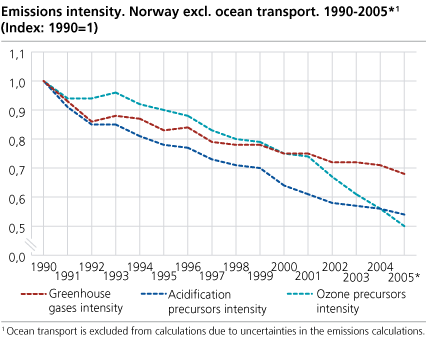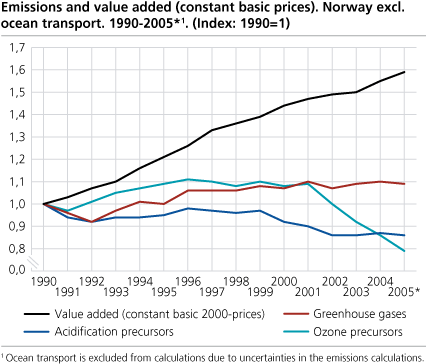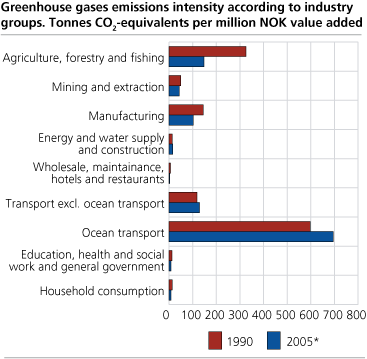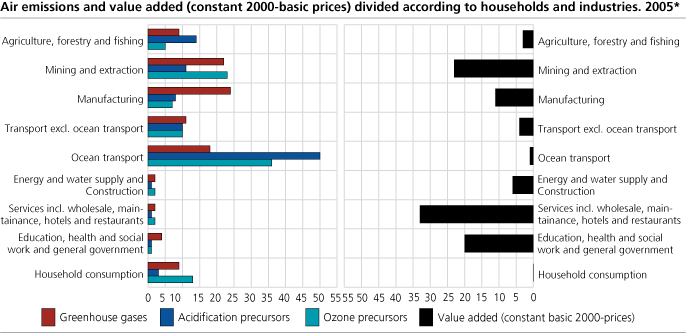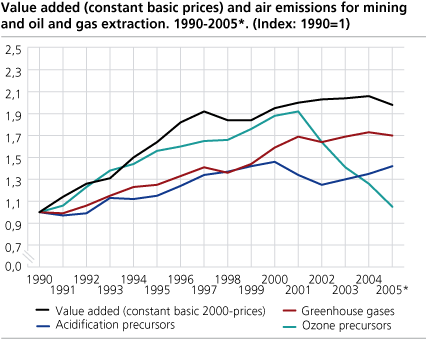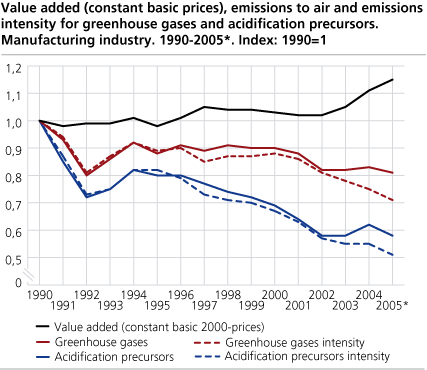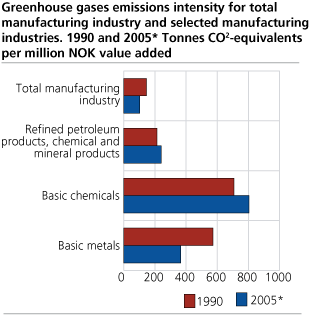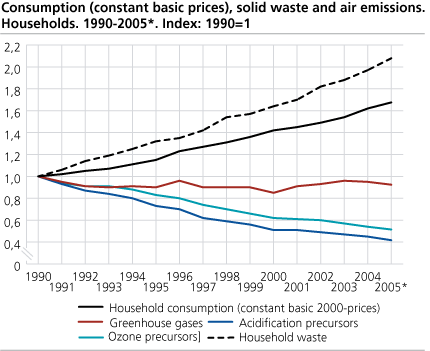Content
Published:
This is an archived release.
Less pollution per NOK
During the period 1990-2005 value added from Norwegian industries in total have increased more than the emissions. Even though the economic growth has been greater than the growth in emissions at the national level, the different industries’ contributions to changes in value added and air emissions vary considerably.
The situation in Norway is illustrated with new figures published from the environmental accounts. Compared with statistics on emissions to air, the focus of this satellite account is to look into the combined development of economic activity and the influence on the environment. Norway is aiming for a decoupling where continued economic growth is combined with reduced emissions.
Revised data for air emissions for the period 1990-2005 as well as revised national accounts data for the period 1995-2005 are included in the environmental accounts. Detailed emission statistics at the level of specific industries for HFK, PFK and SF6 are now also included in the calculations of greenhouse gas emissions. All data from 1990-2004 are final data, while the data for 2005 are preliminary data.
|
The NAMEA-accounts (National Account Matrix including Environmental Accounts) are integrated environmental accounts with the purpose to compare economic and environment related data by combining national accounts data and emission statistics at the level of specific industries. The relationship of specific emissions from an industry to its respective value added is called emissions intensity (measured as emissions in tonnes per NOK value added (production less intermediate consumption)). An industry is more emissions efficient when its emissions intensity goes down. A decrease in emissions intensity occurs when there is a decrease in air emissions and/or an increase in economic growth. For households, the most relevant indicator of economic development is consumption. |
Apparent weak connection between economic growth and emissions
The economic growth in Norway from 1990 to 2005 has been higher than the growth in air emissions. The emissions intensity has shown a descending trend for greenhouse gases, acidification precursors and ozone precursors. However, the picture is very complex, and detailed statistics at the level of specific industries shows that economic growth are lower than the growth in emissions from several industries.
Transport, manufacturing industries and agriculture, forestry and fishing have the highest greenhouse gas emissions intensity. Oil and gas extraction had lower greenhouse gas emissions intensity due to very high levels of value added. With the exception of transport and ocean transport, most industry groups have become more emissions efficient. Agriculture, forestry and fishing are singled out as those industries which have improved the most. This is mainly due to decreases in greenhouse gases combined with strong economic growth for these industries during this time period.
Ocean transport in a class for itself
The environmental accounts use an economic definition of Norway, equivalent to the definitions used in the national accounts. Ocean transport is therefore included in the environmental accounts. Ocean transport singles itself out among the industries in Norway when value added and air emissions are compared. The industry contributes minimally to the value added in Norway but is responsible for a high proportion of total air emissions. In 2005, calculations show that ocean transport contributed to 18 per cent of total greenhouse gases, 50 per cent of total acidification precursors and 36 per cent of total emissions of ozone precursors, but only 1.2 per cent of total value added.
The air emissions from ocean transport strongly influence the total emissions in Norway. Due to uncertainty in the emissions calculations for ocean transport and large fluctuations from year to year, we have chosen to exclude this industry from figure 1 and figure 2. Otherwise, ocean transport is included in the discussion and calculations.
On the right track in 2005, but will it continue?
The preliminary results for 2005 show a small improvement in emissions intensity for greenhouse gases and acidification precursors and a continuing strong downward trend for emissions intensity for ozone precursors. For greenhouse gas emissions and acidification precursors this is due primarily to continued economic growth combined with a small decrease in the emissions of these types of gases. When looking at the national level for 2005, there are signs of decoupling of air emissions from economic activity. Unfortunately there is no reason to believe that this is the beginning of a new trend. Instead, the greenhouse gas emissions are expected to increase again when the natural gas power plants at Kårstø and Melkøya come on line.
Privately owned service industry contributed to more than 50 per cent of the economic growth in 2005. Total value added for Norway increased by 2.4 per cent in 2005 compared with 3.2 per cent in 2004. Service industries are not very emissions intensive, but their growth contributes to a constantly increasing demand for more energy.
A decrease in the greenhouse gas emissions from the manufacturing industries and the extraction of oil and gas partly explains that total emissions of greenhouse gases was 0.9 per cent lower in 2005 compared with the previous year. Of the total emissions of greenhouse gases in 2005, the manufacturing industry, oil and gas activities and road traffic were responsible for 24, 21 and 29 per cent respectively, or 74 per cent in total.
The greenhouse gas emissions from the transport industry are still increasing. When looking at the transport industry, excluding ocean transport and transport via pipelines, the annual increase in greenhouse gas emissions was 3.2 per cent in 2005 compared to 4.9 per cent in 2004. Pollution per NOK value added is still decreasing since the growth in emissions is slightly slower than the growth in the value added.
Increased pollution per NOK in the oil, gas and mining industry...
The oil, gas and mining industry is a major contributor to the economic growth in Norway, but at the same time, the activities in this industry also contribute to a large proportion of total air emissions. In 2005, the oil and gas sector was responsible for 21.7 per cent of total greenhouse gas emissions and 11.4 per cent of total acidification precursors.
In 2005 there was a 2.6 per cent reduction in the total production from the oil and gas industry (measured in Sm3 oil equivalents). Although there was an increase in the production of natural gas and high oil prices, the 7.2 per cent reduction in the production of oil resulted in a decrease in the value added in constant prices from 2004 to 2005.
Emissions of greenhouse gases and acidification precursors from the oil and gas industry have increased at a higher rate than the value added; resulting in an increase in emissions per NOK value added. In 2005, a small decrease in emissions of greenhouse gases is seen, while emissions from acidification precursors increase. This is explained by increasing production levels of natural gas and decreased levels of oil production (see the energy balance ).
Preventive measures in the oil and gas industry to reduce ozone precursors have reduced these emissions by 44 per cent between 2000 and 2005, and emissions per NOK value added are still decreasing. The oil and gas sector was in 2000 responsible for 32 per cent of the total emissions of ozone precursors, but this has been reduced to 23 per cent in 2005.
...but slightly reduced emissions per NOK in the manufacturing industry
In the 1990s, the growth in both emissions and value added in manufacturing industries varied. But, from the end of the 1990s until today, the emissions intensity in the manufacturing has decreased for both greenhouse gases and acidification precursors.
The growth in the emissions have more or less followed the growth in value added, but from 2002 there has been a strong growth in value added for the manufacturing industry. Machinery and other equipment n.e.c has shown good economic growth during the whole period from 2002 to 2005. The increase in value added in the manufacturing industry was dominated by the publishing, printing, reproduction industry in 2003 and 2004, while in 2005 it was the building of ships and oil platforms and the production of wood and wood products that contributed strongly to the growth in the manufacturing industries. The economic growth in these manufacturing industries is due to a number of factors. Individual industries have experienced increased exports and domestic deliveries. For others there was a decrease in the number of manufacturing establishments and the existing establishments were the most profitable ones.
Emissions of greenhouse gases and acidification precursors in the manufacturing industries are mainly due to the production of refined petroleum products, chemical and mineral products and the production of basic chemicals and basic metals. In 2005 these industries accounted for 89.2 per cent of greenhouse gas emissions and 82.7 per cent of emissions of acidification precursors from the totals for the manufacturing industries, while contributing to approximately one fourth of total value added. The production of basic metals shows a different development path than the other manufacturing industries. This industry has become more emissions effective from 1990 to 2005 due to sharply decreasing levels of greenhouse gases emissions and acidification precursors. This decrease can be seen in connection with large environmental protection investments at the beginning of the 2000s (See Environmental protection expenditures in manufacturing, mining and quarrying industries ).
The manufacturing industry contributes 24 per cent of Norway’s greenhouse gas emissions and 8 per cent of total acidification precursors. From 1990 to 2005, greenhouse gas emissions and emissions of acidification precursors from the manufacturing industry have decreased 19 per cent and 42 per cent, respectively. The overall reduction in emissions of greenhouse gases is due to a reduction in emissions of perfluorocarbons (PFCs) and SF6 .These reductions are substantially due to specific measures such as technology improvements and improved process control.
Waste increases more than household consumption
Households’ consumption of goods and services increased in constant prices with 3.2 per cent from 2004 to 2005 compared to a growth of 5.4 per cent the previous year. In 2005, the amount of waste increased by 5.6 per cent, from 378 kg to 407 kg per capita. These figures show that the increase in consumption is lower than the increase in the amount of waste from the households.
As in 2004, there was also an increase in the households’ consumption of clothes, shoes, furniture, household appliances as well as technology goods and leisure equipment in 2005. But also the consumption of tourism services, hotel, restaurant and transport services has increased. Still, it was household consumption abroad, with a 12.9 per cent increase in constant prices that changed the most from 2004 to 2005.
From 1990 to 2005 the emissions to air have moved primarily in the opposite direction than the waste and consumption of the households. The emissions of greenhouse gases and acidification precursors show a downward trend. It is mainly the use of energy for heating and lighting as well as use of own motor vehicles that mainly causes the emissions to air from private households. Consumption of electricity (in constant prices) in households increased with 3.9 per cent from 2004 to 2005, but there was a decrease of 0.3 per cent in the consumption of heating oil and district heating and a decrease of petrol and oil of 3.5 per cent. The emissions to air from private households do not comprise emissions related to imported goods, and cannot be seen as total consumption related emissions. Import of consumer goods has increased in value by 25 per cent in the period 2000 to 2005.
Different definitionsCombining data from the national accounts and environmental statistics is made into a standard framework named NAMEA (National Account Matrix including Environmental Accounts). For further information consult About the statistics ). The NAMEA data are distributed by industry, so as to enable a comparison of economic activity and environmental impacts. NAMEA data uses an economic definition of Norway, which is the same as the one used for the national accounts. Ocean transport and international air transport are therefore included. The NAMEA data are reported to the EU. There are essential differences between the Norwegian NAMEA emissions data and the national data on air emissions that are reported to the Kyoto- and the Gothenburg-protocol and are published by Statistics Norway and the Norwegian Pollution Control Authorities (SFT). The national air emissions data set is distributed by source (such as process emissions, stationary and mobile combustion), independent of which industries that are doing the activity. The data set is based on a geographic definition of Norway. This means that ocean transport and international air transport are excluded, in line with the international air emissions agreements. |
Additional data from the Norwegian Environmental Accounts are available in StatBank Norway .
Tables:
Additional information
Contact
-
Ingrid Semb Weyer
E-mail: ingrid.semb.weyer@ssb.no
tel.: (+47) 40 90 23 51
-
Trine Heill Braathu Randen
E-mail: trine.heill.braathu.randen@ssb.no
tel.: (+47) 91 10 67 45

